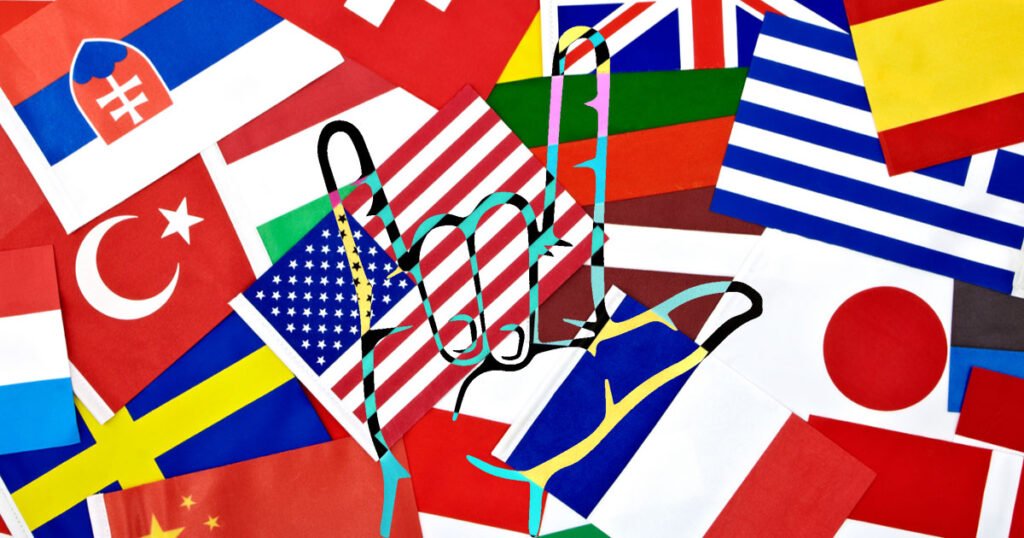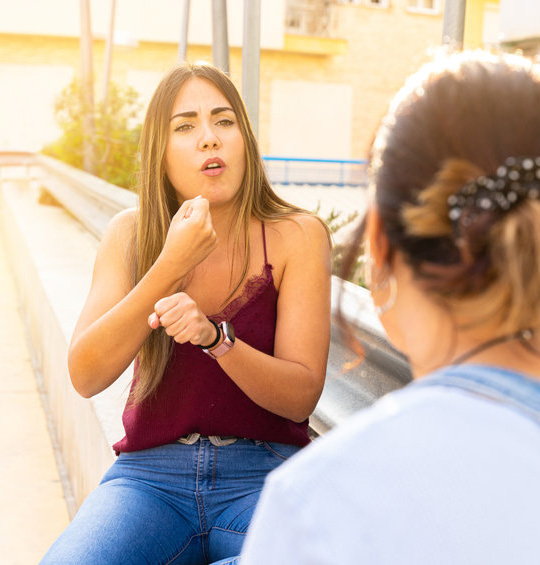Sadly, deaf culture often flies under the radar of the hearing community. This culture is rich in its history, customs, and language. Deaf Awareness Month is held during the month of September, and it is a time to showcase and inform others how the deaf communities around the world come together to celebrate, and bring awareness of deaf-related issues, their culture and language that are unique to the deaf and hard-of-hearing people.

The International Week of the Deaf (IWDP) begins on September 23, 2024 and and ends on September 29, 2024.
The International Day of Sign Language (IDSL) takes place on September 23, 2024.
This tribute to deaf people began in September 1951, and today it focuses on the same things, including:
- Recognize the many valuable features of deafness
- Acknowledge the need to address the social isolation that is a part of deafness
- Promote and support deaf organizations
- Showcase deafness and Deaf culture for the world to recognize the solidarity of deaf people
How to Celebrate Deaf Awareness Month
There are many ways you can celebrate Deaf Awareness Month. Here’s a list of some of them:
- Learn American Sign Language or brush up on your skills. If you’re new to ASL, you can check out the free videos on YouTube. Simply type in the YouTube search box: “learn american sign language” (without the quotes).
- Host or attend deaf events. Deaf schools sometimes hold yearly events. Big cities have these ASL poetry and talent shows. Then there are the ASL coffee chats or socials. You can do a Google search for these type of events (e.g. “asl coffee new york” or “asl events near me”).
- Post and share stories, facts, and videos about Deaf culture on social media such as Facebook, Twitter, YouTube, or Instagram.
- Support deaf-owned local shops and online stores by making a purchase, and recommending them to your friends and family members.
- Organize or participate in fundraisers to support deaf organizations, schools, and other deaf-related causes. A local deaf school for children would be nice.
- If you’re fluent in sign language, offer interpreting services, either free or for a fee, to those who need access to communication.
- If you run a business or non-profit, consider inviting a deaf or hard of hearing guest speaker to share their personal and/or professional experience.
- Hire or help hire more deaf and hard-of-hearing people. Many of them are jobless, but that doesn’t mean they can’t work because they can’t hear. It’s because they face barriers to employment. Many are highly skilled and talented who can do a great job at work.
- Read a book or watch a movie that features Deaf characters, then share your thoughts and recommend these titles to others.
- Learn and educate yourself about famous deaf people who changed the world despite their hearing loss.
- Invite a deaf or hard of hearing classmate or co-worker out for coffee or lunch and learn about their life. The best yet would be to include some deaf friends to this little event.
Tips for Understanding and Interacting with Deaf People
In honor of Deaf Awareness Month, if you’re new to the idea of interacting and communicating with deaf and hard of hearing individuals, here are some tips to help you do that better.
- Don’t get frustrated if someone does not respond to you – they may not hear or understand you.
- If someone is deaf, don’t assume they communicate the same way as all deaf people do. They may prefer to sign in American Sign Language (ASL) or Signed Exact English (SEE), for example.
- Even if someone cannot hear, for whatever reason, they may not want to be associated with any deaf community. This could include people who are hard-of-hearing people, have cochlear implants, or became deaf later in life.
- Social gatherings can be especially difficult for the hard of hearing people when no one knows the best way to communicate with them. For example, background noise, such as music or groups of people talking, can make it hard for them who rely residual hearing or lip reading to understand conversations.
- Referring to a deaf person as deaf-and-dumb, deaf-mute, or hearing-impaired is a serious insult. At least in the United States, it is. Thankfully, the phrases like “deaf and dumb” are not as common as it once was.
- Many deaf people are proud of their deafness and don’t see it as a disability. That being said, it’s best not to make assumptions, like suggesting Cochlear implants, or to feel sorry for them.
- Choices about hearing-assisted technology, such as types of hearing aids or cochlear implants, are specific to each individual, with no one size for all. What works well for one person may not work for another.
- It’s the invisible issue: Many hard-of-hearing people communicate well with hearing people through lip-reading or some form of technology, so it does not seem like the person has trouble hearing. Additionally, just because a hard of hearing person can speak does not necessarily mean that they can hear well.
- Learn different ways to communicate with deaf people. The ultimate act of respect is to educate yourself to communicate with deaf people, including:
- Learn American Sign Language – ASL
- Speak slowly and articulately
- Use your phone to spell out or show pictures
- Write what you want to say on a piece of paper
Did You Know?
As you consider the role of deafness in the world, some of these facts may surprise you:
- Every country has its own sign language: in the United States, it is American Sign Language, or ASL.
- 2 to 3 out of 1,000 children in the United States are born with some level of hearing loss.
- Of all the world’s disabilities, deafness is number 3.
- Hearing loss varies from those who are profoundly deaf to those who have partial loss in one ear.
- April 1917 marked the first public deaf school for children.
- Deaf people can be more direct than hearing people in their communication.
- Most interesting is that statistics show that deaf drivers are better than hearing drivers.
How to Foster Respect and Inclusion
The following are some steps you can take to promote inclusivity and show respect for deaf and hard of hearing people.
Audio and Visual Media
Although it has become more common and required in many educational institutions, the use of captions on everything from TikTok to YouTube to other visual materials provides inclusion through the use of captions and other technology aids.
Speeches and Presentations
Make a point to always face your audience and communicate clearly. When delivering a PowerPoint presentation, be sure not to look at the slides when speaking.
Interpreters
You have probably noticed the increase in the number of sign language interpreters at major events and broadcasts, which is a positive step toward inclusivity. If you’re involved in organizing events or creating media, consider making interpreters or other accessibility features a standard part of your planning.
Speaking to a Deaf Person
Don’t be nervous or shy about talking to a deaf person one-on-one, but there are some things you can do to improve the other person’s understanding. These include the following:
- Be sure to face the person directly.
- Annunciate your words clearly and speak slowly.
- Keep your mouth clear of your hands or any other obstruction so the other person can read your lips.
- Verify that you have been understood and ask if there’s anything more you can do to facilitate the communication.
- Carry on the conversation in a well-lit area.
- To get a deaf person’s attention, gently tap them on the shoulder or in a larger group, turn the lights on and off.
The Achievements of Remarkable Deaf People
The Deaf community has born many accomplished people who should be recognized during Deaf Awareness Month. Some of these people include the following:
Haben Girma
An astonishing achievement for any person, Haben Girma was the first deaf-blind graduate from Harvard Law School. She has since gone on to deal with disability rights from her practice in California.
Linda Bove
Linda Bove became the “voice” of the deaf during her years as Linda the Librarian on the children’s classic television show, Sesame Street.
Chella Man
Chella Man was a multi-faceted performer, producer, and activist. He played a superhero and specifically focused on work around his life involving being transgender, deaf, genderqueer, and Jewish.
Vint Cerf
Vint Cerf was a technology guru who was dubbed “The Father of the Internet” He became deaf at an early age.
Shirley Jeanne Allen
Shirley Jeanne Allen was the first black woman to get a doctoral degree.
Dr. Robert Davila
Dr. Davila was a strong advocate for disability and was appointed to the position of assistant secretary for the office of Special Education and Rehabilitative Services under President George H.W. Bush.
Eugene Hairston
Eugene Hairston was the first deaf, African American boxer.
Juliette Gordon Low
Juliette Gordon Low was the founder of the Girl Scouts.
Audree Norton
Audree Norton was co-founder of the National Theatre of the Deaf.
‘We Do Exist’ Movement on TikTok
During Deaf Awareness Month in 2023, many deaf influencers on TikTok started a movement and posted videos signing “We do exist.” This movement was done to show the hearing population that deaf people are here and making contributions in everyday life. That they deserve to be recognized, respected, and treated fairly just like everyone else. Some of the TikTok influencers in this particular video are J-Tay, Shaheem, Elizabeth Harris, and Lauren Ridloff.
@itskeene.s We do exist! Happy Deaf Awareness Month!! #fyp #wedoexist @J-Tay @Shaheem @rach, Lovely Red @deafthat @Elizabeth Harris @Jacelyn Fincher @ReallyRenca ♬ We Do Exist – Keene
Conclusion
Deaf Awareness Month in September is a time to celebrate Deaf culture, sign language, and advocate for a more inclusive and fair society. While brief exercises like wearing earplugs give you a glimpse into the world of deafness, that doesn’t give you the full picture. The best way is to meet deaf and hard of hearing people to really understand where they come from, learn how they cope with real life in a hearing world, and why they get together once a year to celebrate.
Share this post with your friends using these one-click sharing options:
👉 Click here to share on Facebook.
👉 Click here to share on X.
👉 Click here to share on LinkedIn.

Get the latest interviews, tips and guides in your inbox.